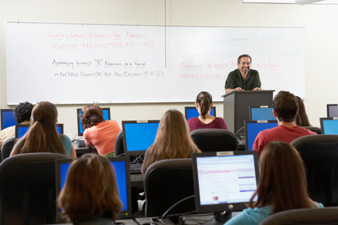
Student SIG Update
By Mallory G. Cases, MPH; and Susan Sharp, MS, Student SIG Liaisons
 In light of SBM's upcoming annual meeting topic of "Technology: the Excitement and the Evidence", I interviewed Heather S.L. Jim, PhD, assistant member at Moffitt Cancer Center in Tampa, FL, who researches side effects and increasing quality of life in cancer patients undergoing treatment. We discussed the role of technology in her NCI-funded R01 in which she will be identifying the magnitude and features of changes in sickness behaviors (e.g., fatigue, depression, and disruptions in sleep and activity) in a large sample of gynecologic cancer patients receiving platinum- and taxane-based chemotherapy and a non-cancer sample. These sickness behaviors will be monitored via actigraph and Internet daily diary. If participants do not have access to the Internet, an iPad will be provided to them with 4G connectivity. Actigraph look like wristwatches and contain accelerometers capable of measuring and storing the degree and intensity of motion every second. Participants will wear these for eight one-week intervals allowing her to monitor sleep and activity disruption.
In light of SBM's upcoming annual meeting topic of "Technology: the Excitement and the Evidence", I interviewed Heather S.L. Jim, PhD, assistant member at Moffitt Cancer Center in Tampa, FL, who researches side effects and increasing quality of life in cancer patients undergoing treatment. We discussed the role of technology in her NCI-funded R01 in which she will be identifying the magnitude and features of changes in sickness behaviors (e.g., fatigue, depression, and disruptions in sleep and activity) in a large sample of gynecologic cancer patients receiving platinum- and taxane-based chemotherapy and a non-cancer sample. These sickness behaviors will be monitored via actigraph and Internet daily diary. If participants do not have access to the Internet, an iPad will be provided to them with 4G connectivity. Actigraph look like wristwatches and contain accelerometers capable of measuring and storing the degree and intensity of motion every second. Participants will wear these for eight one-week intervals allowing her to monitor sleep and activity disruption.
MC: How are you using technology to expand the reach of your research?
HJ: We use actigraphy to measure objective sleep and activity as well as web-based surveys to study side effects of chemotherapy. We are just starting to use tablet-based daily diary systems, which we are very excited about because they allow data to be uploaded to our computers in real time. Our actigraphs also have the capability for remote wireless data uploads. In addition, we are using advances in genotyping and bioinformatics to explore potential biological mechanisms of symptoms much less expensively than previously possible.
MC: What brought you to use technology - necessity, interest, both?
HJ: Interest, definitely. We are very enthusiastic about how emerging technologies can help us help cancer patients.
MC: What are some of the pros/cons of using technology in your research?
HJ: There are many advantages to using technology. For example, web-based data collection can be less burdensome for participants and study staff because it allows skip outs and eliminates the need for manual data entry. It also automatically checks for missing or out-of-range values. In addition, we can monitor compliance remotely and communicate with patients to remind them to complete study measures. Technology also allows us to collect large amounts of data that is date- and time-stamped. This opens up new ways of monitoring behavior and patient-reported outcomes, as well as new approaches for analyzing data. For example, we have recently started to use lead-lagged models of symptom change, which was prompted by the large amounts of time-stamped actigraphy data we had collected. Of course, it's also important to have backup systems in place in case the technology doesn't work correctly! This is another case where real-time data uploads are invaluable, because they can alert us to a malfunction right away.
MC: What opportunities do you foresee for technology to expand the impact of behavioral medicine?
HJ: There are lots of possibilities. In addition to the ones we currently use there are web-based and social media interventions, GPS-based technology, open-source software such as R or PLINK in statistical or genetic analyses, just to name a few. I think we, as researchers, are limited only by our imaginations.